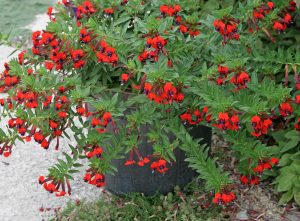 Cuphea llavea is one of about 260 species of Cupheas in the loosestrife family (Lythraceae). This fast growing tender broadleaf evergreen sub-shrub native to Mexico is sold as an annual or houseplant in cooler climates, sometimes under the synonym C. blepharophylla. It is often a conversation plant due to its unique flower shape.
Cuphea llavea is one of about 260 species of Cupheas in the loosestrife family (Lythraceae). This fast growing tender broadleaf evergreen sub-shrub native to Mexico is sold as an annual or houseplant in cooler climates, sometimes under the synonym C. blepharophylla. It is often a conversation plant due to its unique flower shape. 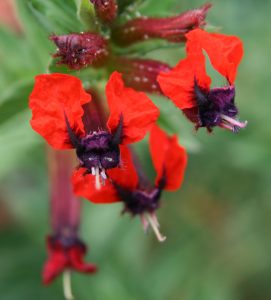 The common name bat-faced cuphea comes from the resemblance of the ends of the flower to a tiny bat face but it may also be called red cuphea or just cuphea (along with several other species; orange bat-faced cuphea is a different species, C. oreophila.)
The common name bat-faced cuphea comes from the resemblance of the ends of the flower to a tiny bat face but it may also be called red cuphea or just cuphea (along with several other species; orange bat-faced cuphea is a different species, C. oreophila.) 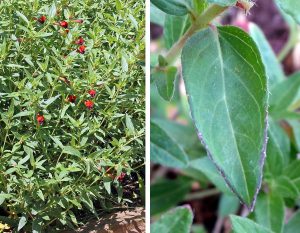 Plants can grow up to 2½ feet tall, but when grown as seasonal annuals generally only become 12-18 inches tall with an equal spread. They have a rounded, bushy habit and the foliage remains fresh all season if watered sufficiently. The stems are crowded with alternate dark green, thick, sandpapery leaves up to 3” long. Each ovate leaf is pointed and hairy. The foliage can tolerate light frost but not a hard freeze.
Plants can grow up to 2½ feet tall, but when grown as seasonal annuals generally only become 12-18 inches tall with an equal spread. They have a rounded, bushy habit and the foliage remains fresh all season if watered sufficiently. The stems are crowded with alternate dark green, thick, sandpapery leaves up to 3” long. Each ovate leaf is pointed and hairy. The foliage can tolerate light frost but not a hard freeze. 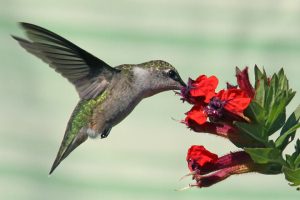 Bat-faced cuphea begins blooming in late spring and continues until frost, producing clusters of numerous flowers in the leaf axils. Each flower has a one inch long, hairy purple calyx with two upward facing red petals at the end, forming the “ears” to go with the “bat face”. The remaining four petals are just little spiny remnants in the species but in some cultivars these are fully developed. Flowers are attractive to hummingbirds, bees and butterflies. The small, brown lentil-shaped seeds are found at the base of spent flowers that remain on the plant.
Bat-faced cuphea begins blooming in late spring and continues until frost, producing clusters of numerous flowers in the leaf axils. Each flower has a one inch long, hairy purple calyx with two upward facing red petals at the end, forming the “ears” to go with the “bat face”. The remaining four petals are just little spiny remnants in the species but in some cultivars these are fully developed. Flowers are attractive to hummingbirds, bees and butterflies. The small, brown lentil-shaped seeds are found at the base of spent flowers that remain on the plant. 
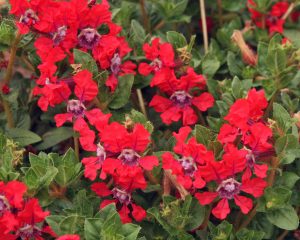 There are a number of cultivars available which vary from the species including:
There are a number of cultivars available which vary from the species including:
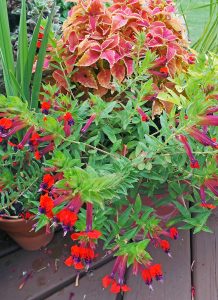 Plant bat-faced cuphea in annual beds, along the edges of borders or paths, or in containers – including hanging baskets – where its unique flowers can be appreciated up close. Combine bat-faced cuphea with plants with purple foliage or bright purple flowers to complement the dark “faces” of the flowers or red flowers, such as bright red impatiens, to coordinate with the “ears”. Use it alone or mixed with other plants such as coleus and ‘Blackie’ sweet potato vine in containers. Container-grown plants can be moved indoors to overwinter in a bright, sunny location with at least four hours of direct sun. Reduce watering and keep relatively cool (in the 60°F’s).
Plant bat-faced cuphea in annual beds, along the edges of borders or paths, or in containers – including hanging baskets – where its unique flowers can be appreciated up close. Combine bat-faced cuphea with plants with purple foliage or bright purple flowers to complement the dark “faces” of the flowers or red flowers, such as bright red impatiens, to coordinate with the “ears”. Use it alone or mixed with other plants such as coleus and ‘Blackie’ sweet potato vine in containers. Container-grown plants can be moved indoors to overwinter in a bright, sunny location with at least four hours of direct sun. Reduce watering and keep relatively cool (in the 60°F’s). 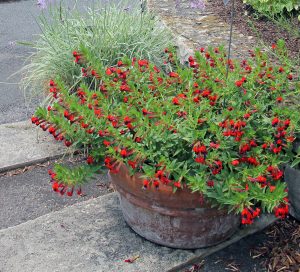 Grow bat-faced cuphea in full sun in the ground or in containers. Provide regular moisture, although plants will tolerate dry conditions occasionally. Fertilize plants in containers several times during the summer months. Pinch back or shear if plants become too leggy later in the growing season. This low maintenance plant has few insect or disease problems but may be infested with whiteflies, mealybugs or aphids. C. llavea is propagated from seed, short softwood cuttings taken in late spring, or large plants can be divided. Start seeds indoors 10-12 weeks before the average last date of frost. The seeds need light to germinate so just press into the soil surface or barely cover. Seeds should germinate in 8-10 days if maintained at 70°F.
Grow bat-faced cuphea in full sun in the ground or in containers. Provide regular moisture, although plants will tolerate dry conditions occasionally. Fertilize plants in containers several times during the summer months. Pinch back or shear if plants become too leggy later in the growing season. This low maintenance plant has few insect or disease problems but may be infested with whiteflies, mealybugs or aphids. C. llavea is propagated from seed, short softwood cuttings taken in late spring, or large plants can be divided. Start seeds indoors 10-12 weeks before the average last date of frost. The seeds need light to germinate so just press into the soil surface or barely cover. Seeds should germinate in 8-10 days if maintained at 70°F.
Bat faced cuphea (Cuphea llavea) is a beloved annual flower known for its unique, bat-shaped blooms. Native to Mexico and Central America, this heat-loving plant is fairly easy to grow from seeds as long as you follow some basic guidelines. In this comprehensive guide, we’ll walk through everything you need to know to successfully plant bat faced cuphea seeds and grow these adorable flowers in your garden.
When to Plant Bat Faced Cuphea Seeds
Bat faced cuphea is a fast-growing annual that can be grown in most regions as long as temperatures are warm Seeds can be directly sown in the garden after all danger of frost has passed,
In colder climates, start seeds indoors 6-8 weeks before the last expected frost date. Since cuphea seeds need light to germinate, do not cover them with soil when planting Ideal indoor growing temperatures are 70-80°F
Once seedlings have reached 4 inches tall and nighttime temperatures remain above 50°F they can be transplanted outside. Wait until the soil has thoroughly warmed in spring usually about 1-2 weeks after the last frost date for your area.
How to Plant Bat Faced Cuphea Seeds Outdoors
To directly sow seeds in the garden:
-
Choose a site with full sun exposure (at least 6 hours of direct sunlight daily) and well-draining soil. Amend clay-heavy soils with compost to improve drainage.
-
Prepare the planting area by loosening soil, removing weeds/debris, and raking smooth. Cuphea prefers slightly acidic to neutral soil with a pH between 6.1-7.8.
-
Plant seeds 1/4 inch deep and 6 inches apart in rows or small groups, keeping adequate space for growth. Bat faced cuphea reaches 18-30 inches tall and 12-18 inches wide when mature.
-
Gently water immediately after planting and keep soil evenly moist until seeds germinate. Use a light mist to avoid washing away seeds.
-
Consider placing a thin layer of mulch around newly planted seeds to retain moisture and regulate soil temperature.
-
Ideal germination temperature is 70-75°F. Expect sprouting in 1-3 weeks. Thin seedlings to 12-18 inches apart once established.
How to Start Seeds Indoors
For an early start, bat faced cuphea can be planted indoors:
-
Start seeds 6-8 weeks before last frost date. Use a seed starting mix or lightweight potting soil in cell packs or containers with drainage holes.
-
Barely cover seeds with soil since they require light to germinate. Gently water and maintain 70-80°F soil temperature.
-
Young seedlings will appear in 1-2 weeks. Provide ample light with 14-16 hours under grow lights or a sunny window. Avoid direct hot sunlight.
-
Transplant seedlings into 3-4 inch pots once first true leaves appear. Grow on at 65-70°F until outdoors nighttime lows are above 50°F.
-
Harden off plants for 7-10 days by slowly introducing to outdoor conditions. Transplant into garden beds after hardening off.
How to Grow Bat Faced Cuphea from Seed Pods
You can also collect and grow bat faced cuphea seeds from the previous year’s plants:
-
Allow cuphea seed pods to fully mature and dry out completely on the plants after flowering ends. Pods will turn brown and brittle when ready.
-
Harvest dry pods and remove seeds. Spread seeds in a single layer on paper towels and allow to further dry for 1-2 weeks.
-
Place dried seeds in an airtight container and store in a cool, dry location until ready to plant. Stored properly, seeds remain viable for 2-3 years.
-
When ready to plant, follow directions above for planting seeds outdoors or starting indoors based on your climate and desired timeline.
Caring for Bat Faced Cuphea Seedlings
Proper care once seeds have germinated will ensure healthy, robust plants:
-
Keep soil consistently moist but not saturated as seedlings establish. Water at soil level to avoid damping off disease.
-
Move sprouted seeds under grow lights or indirect sun. Turn pots regularly for even growth.
-
Transplant into larger containers as seedlings outgrow cell packs or pots. Use potting mix for proper drainage.
-
Begin fertilizing monthly with a balanced liquid fertilizer once true leaves emerge. Alternatively, use compost tea.
-
Maintain daytime temperatures of 65-75°F and nighttime temps above 50°F. Provide ample air circulation.
-
Harden off for 7-10 days before transplanting seedlings outdoors. Gradually increase sun exposure and wind tolerance.
-
Space transplants 12-18 inches apart in garden beds with organic, well-draining soil. Water thoroughly after transplanting.
Common Pests and Diseases
Bat faced cuphea is relatively pest and disease resistant. However, potential problems include:
-
Aphids, whiteflies, mealybugs – Control with horticultural oils or insecticidal soap sprays. Avoid excess nitrogen fertilization.
-
Fungal issues like botrytis, powdery mildew, leaf spot – Improve air circulation. Use copper fungicides if needed.
-
Root rot from overwatering – Allow soil to partially dry out between waterings. Ensure proper drainage.
Ongoing Care for Bat Faced Cuphea Plants
Once your bat faced cuphea seeds have successfully sprouted and seedlings are transplanted in the garden, continue caring for them with:
-
At least 1 inch of water weekly from rain or supplemental watering. Use a soaker hose or water at the base to keep foliage dry.
-
Monthly fertilization with a balanced 10-10-10 NPK fertilizer or compost tea during active growth and flowering.
-
Pruning leggy growth or shaping plants in late winter before new growth begins. Deadheading is not necessary.
-
Mulching around plants to retain moisture and reduce weeds. Replenish mulch annually.
-
Moving container-grown plants to shelter if temperatures drop below 25°F. Plants are root hardy to mid 20s°F.
How to Harvest Bat Faced Cuphea Seeds
To collect seeds for future planting:
-
Allow cuphea flowers to fade completely on plants and seed pods to form after blooming ends.
-
Monitor pods and collect once they turn dry and brown. Wear gloves to avoid irritation from plant hairs.
-
Spread pods out and remove seeds. Further dry seeds for 1-2 weeks on paper towels.
-
Store thoroughly dried seeds in sealed, labeled containers in cool, dry conditions.
Gorgeous Blooms All Season
With its easy care requirements and uniquely shaped flowers, bat faced cuphea is an excellent choice for gardens in warm climates across the country. Follow this guide to successfully plant seeds and enjoy a season full of vibrant, dangling blooms visited by hummingbirds and pollinators. Soon you’ll be hooked on growing these captivating annuals!
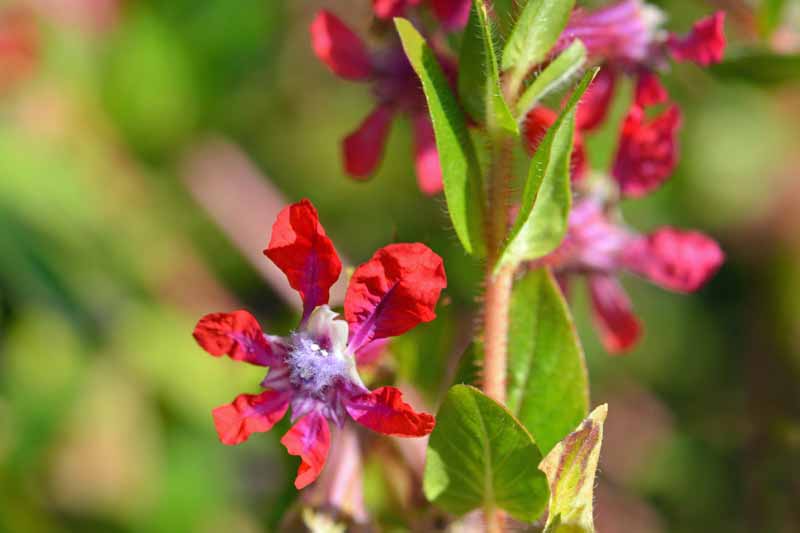
Ask Your Gardening Question
If you’re unable to find the information you need, please submit your gardening question here:
Featured Articles by Season




Bat Face Cuphea Plant (Cuphea llavea) And Cutting Propagation
How do you plant a bat-faced Cuphea?
Combine bat-faced cuphea with red or purple flowers or foliage to complement the flowers. Plant bat-faced cuphea in annual beds, along the edges of borders or paths, or in containers – including hanging baskets – where its unique flowers can be appreciated up close.
How do you grow a bat face Cuphea?
The easiest way to grow cuphea flowers is to purchase bedding plants at a nursery or garden center. Otherwise, start seeds indoors 10 to 12 weeks before the last hard frost in your area. Plant bat face cuphea in full sunlight and the plant will reward you with color throughout the season.
What is a bat face Cuphea plant?
Native to Central America and Mexico, bat face cuphea plant (Cuphea llavea) is named for its interesting little bat-faced blooms of deep purple and bright red. Read this article for helpful informatio
How do you care for a bat faced Cuphea?
For best results, provide plants with: Organic soil. Full sun or part shade, depending on where you live. Regular water. All-purpose fertilizer. Bat-faced cuphea is fairly low maintenance. You can perform some light tip pruning or pinching if plants become too leggy.
